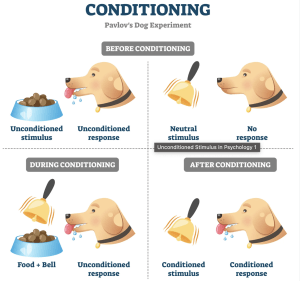A type of learning where an organism learns to associate stimuli is defined as classical conditioning. There are four parts to classical conditioning: unconditioned stimulus, conditioned stimulus, unconditioned response, and conditioned response. Unconditioned stimulus is the stimulus that leads to an automatic response. In Pavlov’s dog experiment, he conditioned a dog. The unconditioned stimulus would be the dog’s food in his experiment. The unconditioned response is the automatic response to a stimulus. So in this case of Pavlov’s experiment, the unconditioned response would be the salvation from the dog when the dog sees food. Pavlov then conditioned the dog with the sound of a bell. The bell would be rang and the dog would be given food. After repeating the conditioning, eventually the dog associates the sound of the bell to food and will start salvation. In this experiment the conditioned stimulus is the bell which is a stimulus that results in the conditioned response. The conditioned response is the salvation from the dog. The conditioned response results from the conditioned stimulus, so in this experiment the sound of the bell makes the dog drool because the sound of the bell is associated with the dog’s food.

“Unconditioned Stimulus in Classical Conditioning: Definition & Examples.” Www.simplypsychology.org, www.simplypsychology.org/unconditioned-stimulus.html.
I have conditioned my dog even though my parents doubted me. I have a small dog named Bentley. I wanted to teach him to put up his paw when I say the word “paw”. His favorite treats to eat are carrots so I had a bunch of carrots ready to give him. In the beginning I would say the word “paw” and use my hands to lift up his paw. Then I would reward him with a carrot. I did that multiple times for 4 days. As I kept doing it, my dog started to learn that in order to get a treat he needs to put up his paw. Eventually, he was conditioned. If I say “paw” to Bentley then he will place his paw in my hand. Most of the time I will still give him a treat after but he will do it without a treat as well. My parents did not think my dog would learn it because he has never been good at learning tricks but I simply told them that it’s classical conditioning and that he would learn after repeated trials. Due to classical conditioning, Bentley is able to do multiple tricks.
I enjoyed learning more about conditioned stimuli and how you trained your dog to respond by raising his paw when you said the word “paw”. I also wrote my blog post about how we trained my dog, Comet, to listen to commands. We used similar methods to get him to respond to the commands. We would start by physically moving his body for him in the desired motion, then after a while, he would start to pick up on the motion and start to do it himself. This method of conditioning has worked for many families trying to train their house pets. the action of having a repeated stimulus and training the dogs that when they see a treat and hear a command they need to perform a certain action has been proven successful in many households. The four parts of classical conditioning, are unconditioned stimulus, conditioned stimulus, unconditioned response, and conditioned response, each plays a crucial role in this process.
I also enjoyed learning about classical conditioning and watching the demonstration videos in class. My experience with this is also with my dog Winter. This relationship has more to deal with operant conditioning than classical but still has the same idea. When she was a young puppy, my family would train her to listen to commands like “sit, stay, paw, and bathroom” but we also taught her a different trick later on. If we are on a walk with my dog, and she is pulling ahead on the leash, we say “heel” and stomp our feet, which hints for my dog to quickly return at our side. This was taught to her by repeatedly acting out this scenario with her and rewarding her when she followed the command. It was interesting to be able to relate my own experiences with something I’ve learned in class.
– Camryn Beers